Arctic Caribou, Nomad of the North. Making a Highway Across Rivers, Ice Fields & Frozen Tundra.
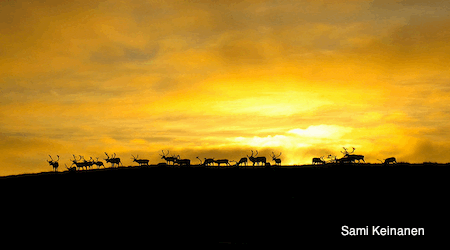
Known as the Reindeer outside of North America the Arctic Caribou is a majestic animal well suited to its environment. Separated into two main groups, the Tundra and the Woodland with various subspecies groups under these. (we will focus on the Tundra group)
There are 3 sub types of the Tundra Caribou found in North America they are…
• Peary
• Barren-Ground
• Porcupine or Grants
There are also two other sub types under the Tundra group that are found outside of North America. They are, Svalbard Reindeer found on the Svalbard Islands of Norway and Mountain Reindeer found in the Arctic Tundra of Asia and Northern Europe.
In North America the Peary Caribou are found in the extreme northern areas known as the Queen Elizabeth Islands of The Northwest Territories and Nunavut. These islands include Ellesmere, Axel Heiberg, Devon, Bathurst, Melville, Ellef Ringnes and Cornwallis, also on Victoria, Prince of Whales and Somerset Islands as well as the Boothia Peninsula along with other localized areas.
The Barren-Ground Caribou are not found as far North as the Peary, they are found in and migrate thru areas of The Northwest Territories and Nunavut. From the MacKenzie Delta region in the west, to Baffin Island in the East, to Banks and Victoria Islands in the North and to the Northern areas of Saskatchewan and Manitoba in the South.
The Porcupine Or Grants Caribou occupy the areas of North West North America in Alaska the Yukon and the extreme North West regions of The Northwest Territories.
Below is a map from the Canadian Wildlife Service which shows their areas of distribution.
Click on the map to go to The Canadian Wildlife Service Website
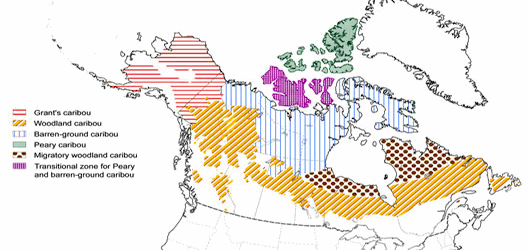
The Caribou has a fur coat well suited to the cold conditions of its habitat. The coat has two layers of fur, one inside that is a dense woolly undercoat, which is covered with a outer layer composed of long hair that are hollow and air filled, this combination protects the animal from the extremely cold temperatures that it must endure for an extended period each year.
In North America the Peary Caribou have a coat that is much whiter than it's cousins farther South whose coats are a darker colour, those colours also change with the seasons. As well as the variance in coat colour the Northern animals are smaller in size than the larger southern animals.
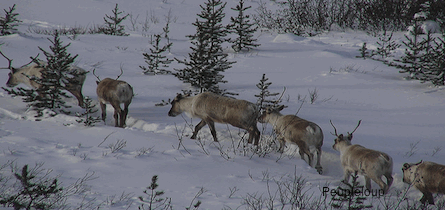
Arctic Caribou love Lichen also known as Reindeer moss. In winter with their excellent sense of smell they will find Lichens under the snow and dig the snow away with their hooves. Lichen can take several years to grow in the Arctic region so the Caribou have to always keep on the move to find a new food source.
Southern Caribou will also eat various leaves and grasses.

Reindeer Moss/Lichen
The effects of climate change, industrial development and other issues have caused concern within some of the Caribou herds in the North. The Beverly and Qamanirjuaq herds are Tundra Caribou that migrate across the North each year in search of food and suitable breeding grounds. In 1982 the aboriginal led Beverly and Qamanirjuaq Caribou Management Board (BQCBM) was formed to advise on how to best manage those specific herds. Numbering over 500,000 animals the goal is to see them thrive in their traditional environment well into the future.
Click here for the BQCMB website
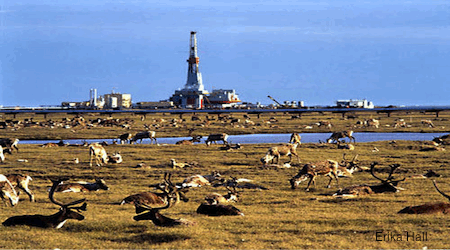
Caribou or Reindeer has been a very important animal all through history for the survival and well being of the North's aboriginal peoples. From providing fur coats for clothing and shelter, meat for food and antlers and bones for tools and weapons. Reindeer has also been domesticated and used as beasts of burden and milk production.
No, Reindeer cannot fly... at least not the kind we talk about here, but they have been used in teams to pull sleighs, so maybe???
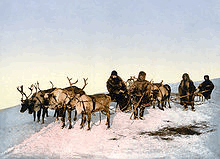
Reindeer Sleigh, Arkhangelsk, Russia
In short The Caribou is a very important animal to the continued success of the Polar region for food, shelter, clothing and many other uses. Their strength, endurance and design has made them uniquely suited for their Northern home. They are an absolute marvel of nature with some herds migrating in excess of 5000 kilometres annually with speeds of up to 80km/h. Travelling over tundra and frozen sea, swimming across lakes and rushing rivers in a never ending search for food and hospitable habitat.
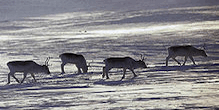
Peary Caribou in the High Arctic
Return from Caribou to Home Page
Return from Caribou to Arctic Animals







